Day I- ancient & divine
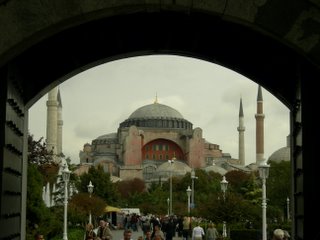 Sultanahmet Camii or The Blue Mosque was built by the eponymous Sultan Ahmet I, an Ottoman emperor set to outdo the nearby Hagia Sophia. As you exit his creation, this is the view of Ayasofya that greets you. A few steps on and you are right the middle of two of the most famous sights of Istanbul. Looking back, the grandeur of the Blue Mosque seems more complete- almost like this is how you were meant to see it- standing at Hagia Sophia which it was built to overshadow. (or as –d perfectly put it a “main dikhata hoon” or “I’ll show you what we can do” sort of thing).
Sultanahmet Camii or The Blue Mosque was built by the eponymous Sultan Ahmet I, an Ottoman emperor set to outdo the nearby Hagia Sophia. As you exit his creation, this is the view of Ayasofya that greets you. A few steps on and you are right the middle of two of the most famous sights of Istanbul. Looking back, the grandeur of the Blue Mosque seems more complete- almost like this is how you were meant to see it- standing at Hagia Sophia which it was built to overshadow. (or as –d perfectly put it a “main dikhata hoon” or “I’ll show you what we can do” sort of thing).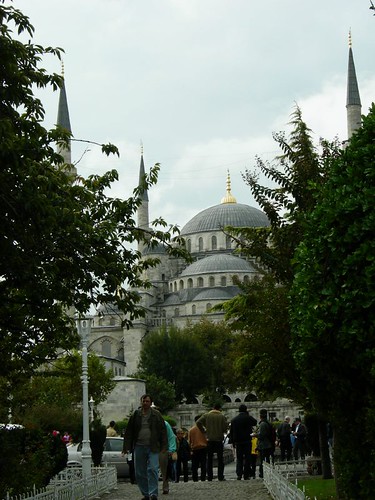 Its very history is head-shakingly different. Built as a church about 14 centuries ago, it was the grandest in Christendom till about a 1000 years later when Rome gave the world St Peter’s Basilica (when do we go to Rome, now? hmmm…). Almost a 1000 years after it was made, Sultan Mehmet converted it to a mosque.
Its very history is head-shakingly different. Built as a church about 14 centuries ago, it was the grandest in Christendom till about a 1000 years later when Rome gave the world St Peter’s Basilica (when do we go to Rome, now? hmmm…). Almost a 1000 years after it was made, Sultan Mehmet converted it to a mosque. 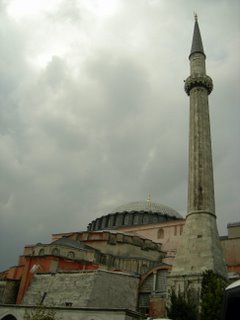 Not 500 years later, the great Ataturk finally declared a museum open to all. So what is it today- a church? A mosque? A (mere) museum?
Not 500 years later, the great Ataturk finally declared a museum open to all. So what is it today- a church? A mosque? A (mere) museum?
We enter with our Lonely Planet in hand, making sure we follow its guide to the imposing second door. But step from it into the inner narthex, and you might as well shut your guidebooks awhile. High up above us, crowning the entrance to the main hall, is a glowing, beautiful and terribly old mosaic- this is Jesus as Pantocrator, or ruler of the world.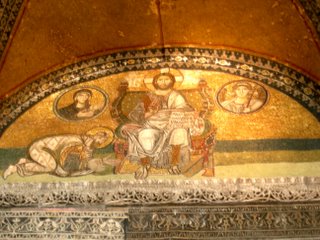
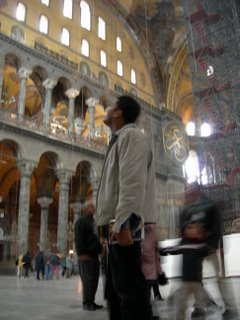

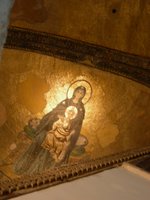
 The corridors on the side have little tombs, a wooden high-chair, prayer rooms, intricate metal work and walls. There is also a little hole in the wall- stick a finger in, if it comes out moist you’ll be cured of ailments- or so they say. Except at the hole, people were sticking their thumbs in and doing the ‘try to make a full circle with it’ thing. Either way, D manages to do it- so expect a new and renewed D!
The corridors on the side have little tombs, a wooden high-chair, prayer rooms, intricate metal work and walls. There is also a little hole in the wall- stick a finger in, if it comes out moist you’ll be cured of ailments- or so they say. Except at the hole, people were sticking their thumbs in and doing the ‘try to make a full circle with it’ thing. Either way, D manages to do it- so expect a new and renewed D!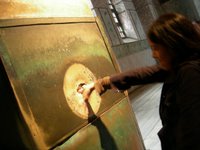
The best part of the second level is probably the walk to it. A narrow passageway with light and shadow- the kind from a period film set- where D sees impressive people and robes and horses, I see dark intrigue and hooded conspiracy. I almost believe the light is torchlight, that any moment we would hear the clip-clop of horses on stone, carrying someone important up. At the end of the walk up we reach the second level- here there is more grey light from windows, and less mystery. But there is much to see that is closer, intricacies that are more wondrously evident.
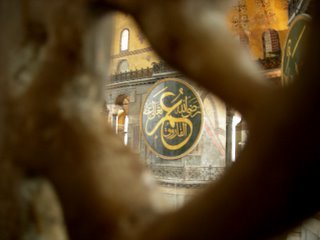 The high windows are like the kind in a video game (Prince of Persia, anyone?)- I must lift D for her to peek out. But the view is almost transporting- Ayasofya’s own domes fill up the frame, while in the distance is the Blue Mosque- it is a proximity that might have been born of envy or one-upmanship, but our world, our time, is much the better for it.
The high windows are like the kind in a video game (Prince of Persia, anyone?)- I must lift D for her to peek out. But the view is almost transporting- Ayasofya’s own domes fill up the frame, while in the distance is the Blue Mosque- it is a proximity that might have been born of envy or one-upmanship, but our world, our time, is much the better for it.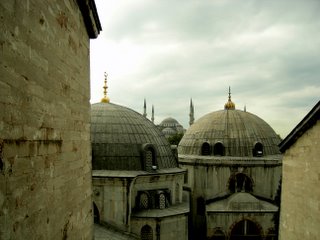 our ayasofya pics
our ayasofya pics

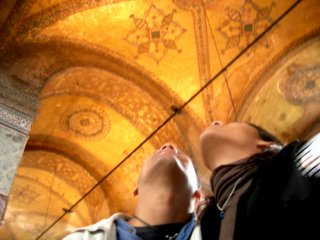
No comments:
Post a Comment